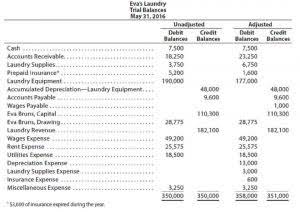Just like your liabilities, your expenses must be kept close track of to ensure that your revenue is put to proper use. Without expenses properly and promptly paid, your company could suffer from consequences that affect your normal operations. Susan Guillory is an intuitive business coach and content magic maker. She’s written several business books and has been published on sites including Forbes, AllBusiness, and SoFi.
- This treatment comes under the accruals concept in accounting.
- Understanding the difference between accrual basis and cash basis accounting can shed light on revenue recording.
- Revenue recognition principles within a company should remain constant over time as well, so historical financials can be analyzed and reviewed for seasonal trends or inconsistencies.
- The following month, the art store owner pays off $200 toward the loan — $160 goes toward the principal and $40 goes toward interest.
- This system provides a clear and comprehensive view of a company’s financial transactions and performance.
This prevents anyone from falsifying records and paints a more accurate portrait of a company’s financial situation. As you can see, this is the funding that your brand pulls in after its responsibilities are met and paid. It is important that you keep a tight grip on this income, as it can cause some serious imbalances within your books and record-keeping if it isn’t properly accounted for. While the same is true for all accounts, many first-time business owners make the mistake of improperly calculating and accounting for equity due to not covering liabilities correctly.
So you will generally be taxed on $20,000, not $300,000, and that tax bill will be lower, thanks to those expenses. When companies offer sales returns, discounts, or allowances, they must report their net sales on the income statement. The above three entries do not require a company to record revenues when it receives cash. This treatment comes under the accruals concept in accounting.
In Accounting, Why Do We Debit Expenses and Credit Revenues?
She writes about business and personal credit, financial strategies, loans, and credit cards. Another good idea to ensure you’re a low-risk investment is to take a look at your business credit report to understand how creditors see your company. That, along with checking your business credit scores, can help you have a good handle on your finances. Shareholders’ equity is the net amount of your company’s total assets and liabilities.
The requirements for tend to vary based on jurisdiction for other companies. In many cases, it is not necessary for small businesses as they are not bound by GAAP accounting unless they intend to go public. Performance indicates the seller has fulfilled a majority of their expectations in order to get payment. Measurability, on the other hand, relates to the matching principle wherein the seller can match the expenses with the money earned from the transaction. The old guidance was industry-specific, which created a system of fragmented policies.
What is Revenue Recognition Principles?
As an example of revenues being credited, a company sells $5,000 of consulting services to a customer on credit. One side of the entry is a debit to accounts receivable, which increases the asset side of the balance sheet. The other side of the entry is a credit to revenue, which increases the shareholders’ equity side of the balance sheet. Thus, both sides of the balance sheet remain in balance as a result of this transaction. Understanding how to record revenue correctly is vital for maintaining accurate financial records. In double-entry bookkeeping, revenue is typically recorded as a credit entry to the revenue account, representing an increase in income.
When dealing with a corporation, credit balances go into what is known as Retained earnings, which is essentially a stockholder’s equity account. In this guide, we will discuss what all this means and why revenue has to be recorded as a credit. When a sale occurs, the revenue (in the absence of any offsetting expenses) automatically increases profits – and profits increase shareholders’ equity. Stated differently, operational management challenges the act of generating revenue also increases either cash or accounts receivable, which calls for an offsetting credit entry to equity. Before going into the specifics of whether revenue is a debit or credit, it’s crucial to understand the nature of revenue accounts. Revenue accounts are part of the income statement, representing the money earned by a business through its primary operations.
Whereas debits decrease revenue, liability, or equity, accounts, credits increase them while decreasing expense or asset accounts. To help you better understand why exactly revenues are credited, consider that a business gets $1,000 for a service that it provides, thus earning that $1,000. And since a credit entry is now present in the Service Revenues, your equity will effectively increase as a result. If you have a customer that purchases your services for, say, $700 but you allow them to pay you over the course of 30 days, your accounts receivable will receive a $700 debit. This means that you will need to record a $700 credit in the Service Revenues . A customer buys one and you deposit the $300 into your business’s bank account right away without delay.
Is an Expense a Debit or a Credit, and Why Are People Often Confused By This?
For the past 52 years, Harold Averkamp (CPA, MBA) has worked as an accounting supervisor, manager, consultant, university instructor, and innovator in teaching accounting online. He is the sole author of all the materials on AccountingCoach.com.
Revenue recognition principles within a company should remain constant over time as well, so historical financials can be analyzed and reviewed for seasonal trends or inconsistencies. Revenue accounting is fairly straightforward when a product is sold and the revenue is recognized when the customer pays for the product. However, accounting for revenue can get complicated when a company takes a long time to produce a product. As a result, there are several situations in which there can be exceptions to the revenue recognition principle. While revenue is typically credited, there are instances where a debit to revenue may occur.
Is Revenue a Debit or Credit? Business Accounting 101
If you’re considering selling your business, a potential buyer will want to see what assets you have on the balance sheet. If, for example, you have a debit of $1,000 from the purchase of a new computer, you would then create an equal credit for the asset of the computer. Due to being an income https://www.kelleysbookkeeping.com/nynab-vs-quickbooks-online/ and positively impacting equity, revenue is a credit in accounting. However, discounts, allowances, and sales returns may reduce it. The residual amount after subtracting these is known as net sales. Similarly, it made sales of $300,000, for which it received cash through the bank.
That’s why simply using “increase” and “decrease” to signify changes to accounts wouldn’t work. Revenue recognition is a generally accepted accounting principle (GAAP) that identifies the specific conditions in which revenue is recognized and determines how to account for it. Revenue is typically recognized when a critical event has occurred, when a product or service has been delivered to a customer, and the dollar amount is easily measurable to the company. The art store owner gets a loan for $2,000 to increase inventory in the shop. They record the $2,000 loan as a debit in the cash account (as an asset) and a credit in the loans payable account as a liability.







